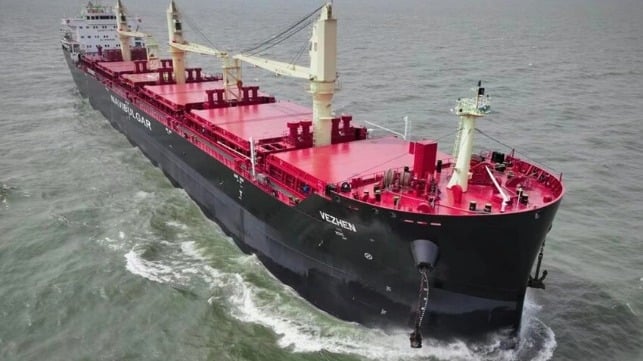Sweden Releases Bulker Saying Cable Damage was Accident Not Sabotage

Sweden’s Prosecutor’s Office released the Navibulgar bulker Vezhen it had seized a week ago as part of its preliminary investigation into damage to a subsea cable running between Latvia and Sweden. They said while they were convinced this was the vessel that caused the damage, they accepted the explanation from the shipping company of an accidental release of the anchor during a Baltic storm.
“The investigation now clearly shows that it is not a case of sabotage,” Senior Prosecutor Mats Ljungqvist at the National Security Unit of the Swedish Prosecutor’s Office. “It has been established that a combination of weather conditions and deficiencies in equipment and seamanship contributed to the cable break.”
Navibulgar had asserted that it was an accidental release of the chain from the anchor while the captain reportedly told investigators that the system was damaged while the vessel was in Russia. The bulker Vezhen (32,196 dwt) built in 2002 and registered in Malta, had departed Ust-Luga, Russia on January 24 and two days later the cable damage was reported south of Gotland, Sweden.
Ljungqvist told Reuters that they had reviewed video footage showing waves hitting the anchor and the release of the chain. They reportedly determined that two of the three locking mechanisms for the anchor had been out of service for a “lengthy period” and that the ship was dependent on a manual release. He admitted the ship was dragging its anchor for 24 hours but said the crew failed to notice the drop in speed, and that the autopilot was compensating for changes in the direction of the ship.
The Swedish Coast Guard participated in the investigation saying it could analyze the movements of the ship and sea conditions. The Swedish Navy and the police were also assisting in the investigation. Prosecutors said they had conducted a large number of interviews, seizures had been made and analyzed, and crime scene investigations were carried out.
Navibulgar had released a statement shortly after the vessel was detailed insisting “this is a force majeure situation that occurred due to the unfavorable hydrometeorological conditions in the area.”
The vessel’s AIS signal reflected that it was underway at a speed of 11 knots late on Monday, after the announcement from the Swedish authorities. It is showing Skagen, Denmark as its destination.
“The preliminary investigation is currently continuing to determine whether there are other crimes that may be suspected in connection with the cable break-in,” the Prosecutor’s Office said in its written statement.
While the region remains on alert with added patrols of its undersea infrastructure, this is the second instance in days when authorities decided to release a suspected vessel. On Friday, January 31, Norway stopped a cargo ship and directed it to port at the request of the Latvian authorities. At the end of the day, they reported they found no evidence of the ship’s involvement with the damage to the undersea cables and determined the vessel should be permitted to proceed.
Sweden, Finland, and Estonia each reported increased patrols after the recent incidents. They also won support from NATO as well as a UK tracking system to further enhance security measures in the North Sea and Baltic. Russian authorities have repeatedly asserted that they were not involved with any of the recent cable damage incidents.
